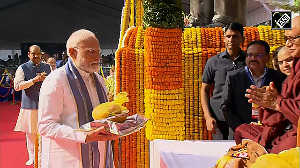Dussehra in Mangaluru is incomplete without the iconic Pili Vesha or tiger dance, a deeply rooted tradition in Tulu culture.

All photographs, videos: Kind Courtesy Kalicharan Friends Boloor/Instagram
In the wake of India's historic World Cup victory in 1983, cricket enthusiasts in Mangaluru sought to commemorate the triumph by establishing a new cricket club.
Instead of honouring the World Cup-winning skipper, the legendary Kapil Dev, the club's founders were inspired by another equally remarkable cricketer: Alvin Kallicharran.
The Indo-Guyanese cricketer who played Test cricket for the West Indies between 1972 and 1981, Kallicharran's legacy resonated deeply with the club's members.
This unique choice set the stage for the formation of Kalicharan Friends Boloor.
The Shobha Yatra

Dussehra in Mangaluru is incomplete without the iconic Pili Vesha or tiger dance, a deeply rooted tradition in Tulu culture.
This vibrant spectacle involves men meticulously painting their bodies with intricate yellow and black stripes to resemble a tiger or black rosettes over orange and cream to resemble a leopard or the spots of a cheetah. This process that can take anywhere from six to eight hours as multiple layers are carefully applied.
In its inaugural year, Kalicharan Friends Boloor experienced rapid growth, fuelled by their passion for Pili Vesha.
The group's debut performance at the prestigious Gokarnanatheshwara Temple, also known as Kudroli Sri Gokarnanatha Kshetra, was marked by the rhythmic beats of the taases(drums) as human tigers energetically stepped out to dance.

The Dussehra festivities at Mangaluru's Kudroli Gokarnanatheshwara temple culminate in a spectacular Shobha Yatra.
Thousands of devotees gather to witness the vibrant procession, featuring intricately decorated vehicles adorned with the Goddess Sharada and the Navdurgas, along with other tableaux.
Kalicharan Friends Boloor's unwavering dedication and exceptional skill have ensured their tableau's prominent position in the Shobha Yatra for the last 25 years.
The Black Tiger

Kalicharan Friends Boloor introduced a groundbreaking innovation to Tulunadu's Pili Vesha in 1999 -- the black tiger.
Under the leadership of senior artist Ram, the group aimed to create a visually striking variation of the traditional tiger dance.
The first black tiger was brought to life by Pursanna, followed by the legendary Naveen, who became synonymous with the unique dancing style associated with the black tiger.
To achieve the desired black appearance, Ram used dark black paint for the tiger's body. However, the white fur of the toppi (the tiger mask that covers the dancer's head completely) clashed with the new colour. A creative solution was found when a team member quickly purchased black dye from a local salon and dyed the toppi, completing the distinctive black look.
The black tiger's bold and unique appearance immediately captivated audiences.
As a testament to the black tiger's significance, Kalicharan Friends Boloor still preserves the original black toppi worn by Pursanna -- it remains a prized possession -- in their office, says president Vijender Salian.
"The introduction of the black tiger was a turning point for our group. It brought a unique and striking element to our performances and quickly gained attention from our audiences," Salian adds.
Celebrating 40 Years

As Kalicharan Friends Boloor celebrates its 40th anniversary, they continue to impress audiences with their vibrant and energetic performances.
With four tableaux planned for the Shobha Yatra, including a Pili Vesha and a carnival-themed tableau, the group is set to create another unforgettable memory.
Gautam, a member of Kalicharan Friends Boloor, explains that each tableaux costs between Rs 1 and Rs 1.2 million and, when you include the cost of paints for the pilis (tiger in Tulu), the total expenditure rises to Rs 1.6 million to Rs 1.7 million.
While they typically have 40 pilis participating each year, their 40th anniversary celebration will feature a remarkable 70 pilis.
The intricate dance sequences of the Pili Vesha are mastered through a combination of practice and observation.
"There are 10 basic dance steps and the dancers mix and match them to create unique performances. It's so easy to learn that you can pick it up after watching just three-four times," Salian says.
The dedication of the Pili Vesha dancers is truly commendable; many juggle their passion for the dance with demanding day jobs. Salian highlights this commitment, stating, "Tiger dancers often work part-time, focusing on festivals like Janmashtami and Dussehra."

Gautam echoes this sentiment, sharing a story about the legendary Naveen. "Even Naveen, despite his fame, used to work in Mumbai and would take time off during Dussehra to perform and then return to his regular life.
"Passion is the driving force behind our group. We encourage our members to embrace the traditions of tiger dance and perform with enthusiasm. While financial gains are important, we believe that passion should always come first."
Tilakraj Kotian, a long-time member who joined Kalicharan Friends Boloor at the tender age of 12, reflects on his journey. "Being a part of this incredible group has been a truly rewarding experience. I've witnessed firsthand how the group has grown and evolved over the years," he says.
Kalicharan Friends Boloor remains committed to preserving the traditions of Pili Vesha. They encourage young people to join the group and learn the art form.
While they do not participate in competitions for monetary gain, they have achieved significant success in the few competitions they have entered, such as the Pili Parba in 2022 organised by Kudla Samskritika Prathisthana.
As Kalicharan Friends Boloor looks to the future, they are confident in their ability to continue inspiring audiences with their innovative and captivating performances.












 © 2025
© 2025